Sourdough French bread is a simple and classic recipe with a fluffy texture and crusty exterior. Knead the night before and allow it to ferment overnight, then shape, rise, and bake the next day. It’s wonderfully simple.
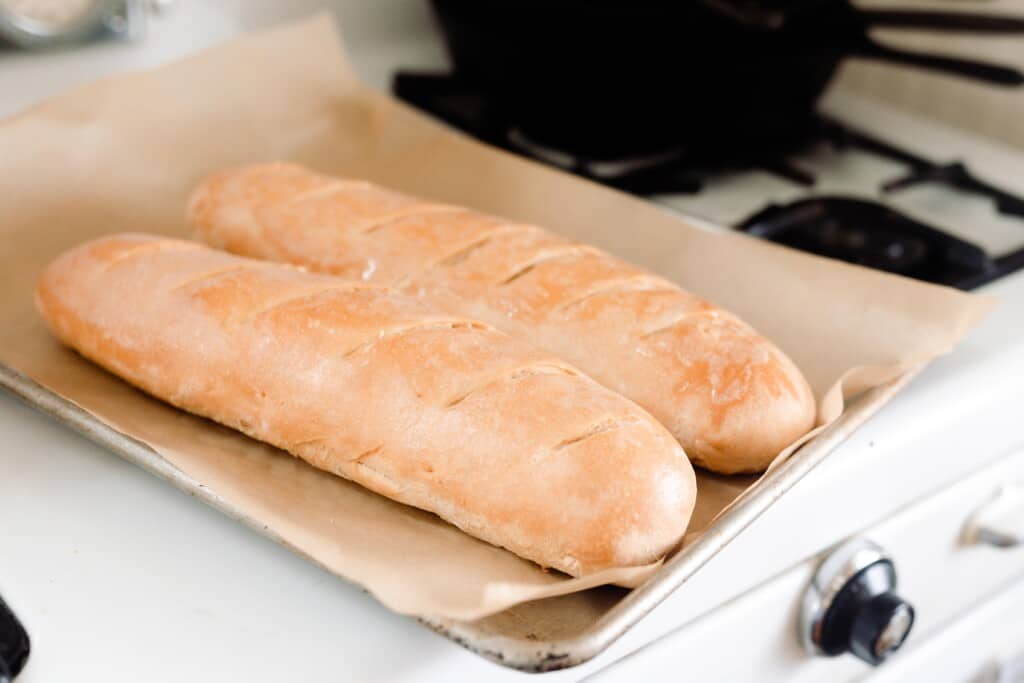
There is nothing better than a crusty loaf of bread. Slice it thick and spread with homemade butter, and now you are speaking my language.
Most French bread recipes call for instant yeast, which I almost never keep in my pantry, except for that rare occasion I want to make this einkorn sandwich bread.
Once you switch to fermenting grains and using wild yeast to leaven bread, it’s hard to go back to the conventional fast-rising breads. It lacks the flavor that develops during that slow rise.
But it is a delicate balance, because that fluffy center can sometimes be a challenge to perfect with sourdough.
These sourdough French baguettes have all the good qualities one can hope for. Crusty outside with a fluffy, tender texture inside. It’s perfect to serve as garlic bread, or with a bowl of soup.
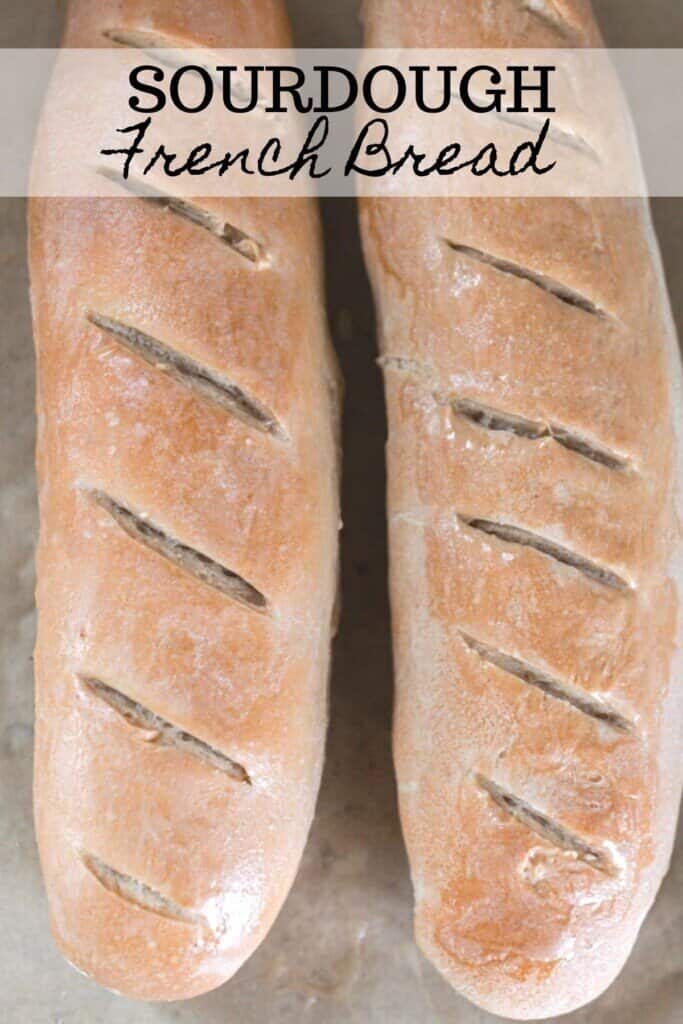
Why you will love this recipe:
- Super simple. Start the night before and allow to ferment and rise overnight. The next day, all you have to do is shape, allow to rise, and bake. It’s a perfect almost-make-ahead side.
- Fermented grains for easier and better digestion. There is no doubt we love sourdough in our house. Not only is it tasty, but the fermentation process helps break down phytic acid, making it more nutritious, and helps break down the gluten, making it easier to digest.
- Delicious. This recipe is everything you love and hope for in a French bread: crusty exterior with a soft and fluffy inside. Use it as a side, garlic bread, or slice it in half to cover with sauce, cheese, and pizza toppings and now you have a pizza bread. This last particular idea was one my mom made us for a quick dinner growing up.
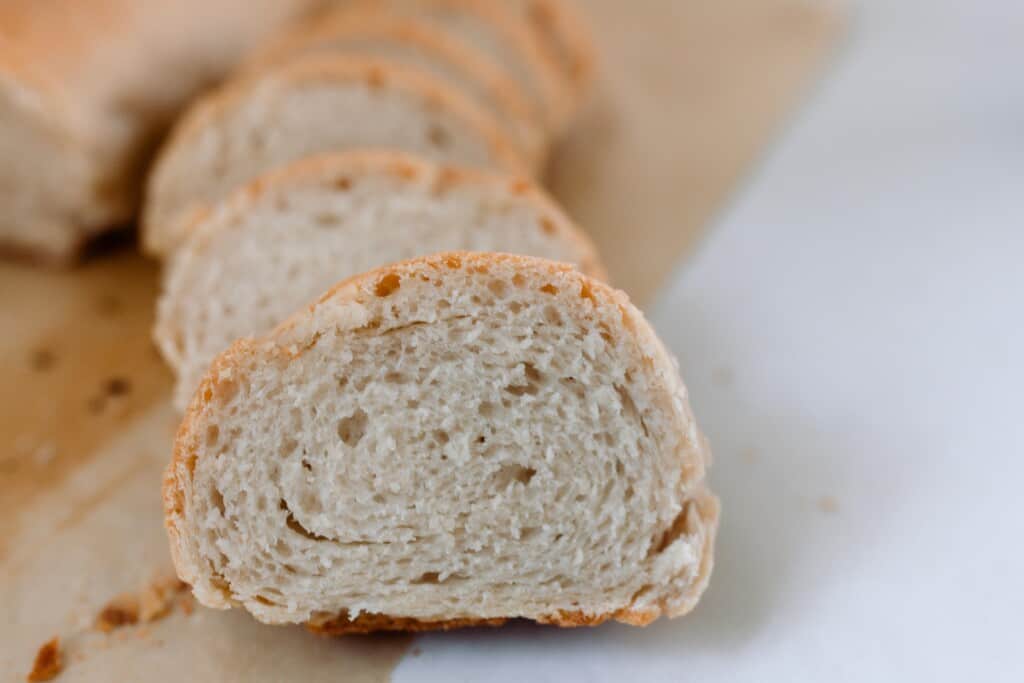
Is French bread the same as sourdough?
No. While they are similar, most French breads are not made with sourdough, but rather with conventional rapid yeast. You can easily make it into sourdough French bread by using this recipe. Just know that most French breads you buy from the store will use yeast.
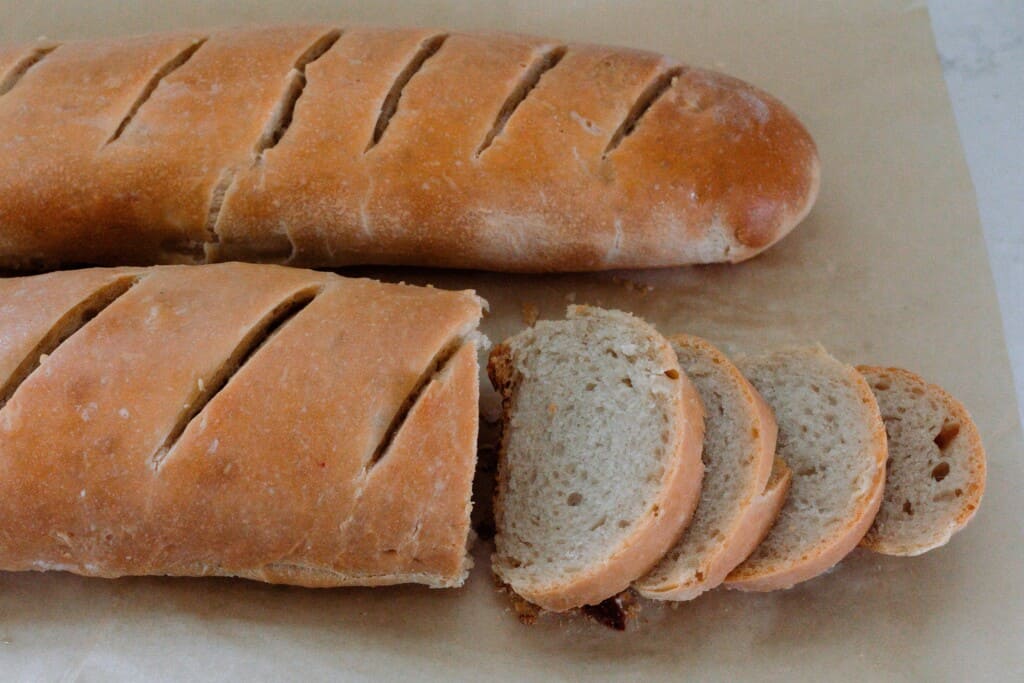
Sourdough French Bread Tips:
- For a soft, fluffy, sourdough bread baguette, your dough should be on the wetter side. A dry dough will leave you with a drier loaf.
- To make those perfect long loaves, I like to roll it out into a rectangle and then roll it up and pinch the ends. This allows for a more even loaf for a better shape and more even baking time.
- To give the baguettes a crustier outside, place a few ice cubes in the oven. This will release steam and achieve that beautiful, golden crust.
- New to sourdough? Learn how to make a starter and care for it. Once you get the hang of it, I promise it is really easy. You can even make a ton of recipes from sourdough discard.
This post contains affiliate links, which means I make a small commission at no extra cost to you. See my full disclosure here.
Tools you may need:
Stand mixer with dough hook.
Measuring cups and spoons
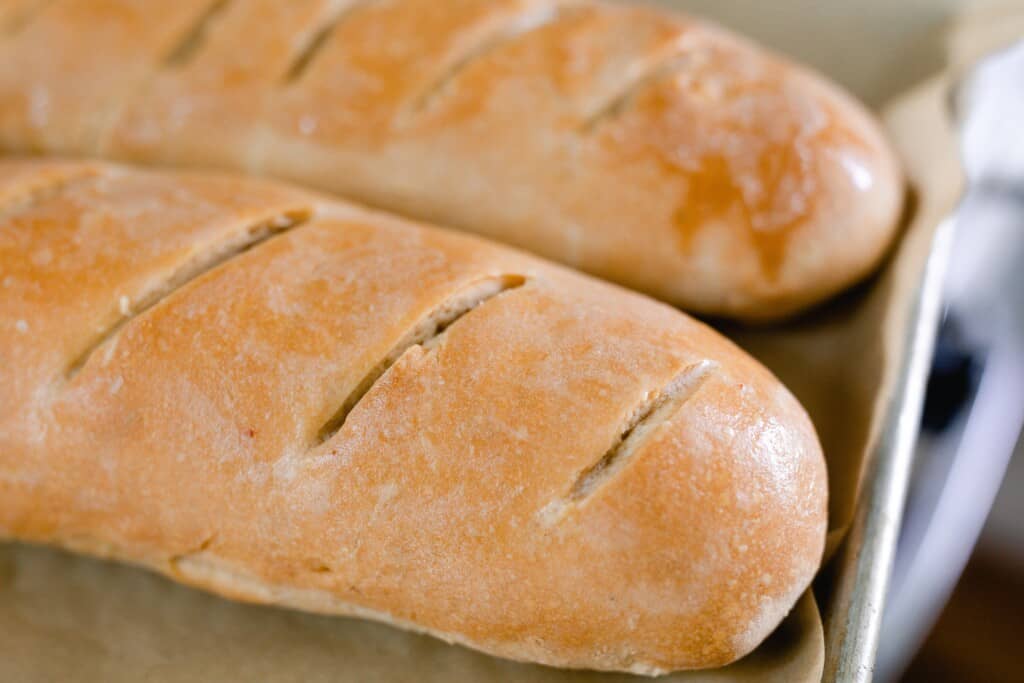
How To Make Sourdough French Bread
Feed your starter 4-12 hours before starting this recipe. It should be very active and bubbly.
To your mixing bowl, add all of the ingredients.
Knead in a stand mixer using the dough hook until stretchy and pulling away from the sides of the bowl. This should take about 5-10 minutes. It should pass the ‘windowpane’ test, which is when you take a small piece of the dough and try to stretch it into a square-like shape. If you can stretch it thin enough where you can “see through it”, then the gluten formation is adequate.
If it doesn’t pass this test and is breaking apart, then place it back into the stand mixer and knead for a few more minutes.
Place in a large, oiled bowl and cover with plastic wrap, beeswax wrap, or something that is airtight. This will keep the dough moist, preventing it from developing a hard skin.
Allow to ferment for 8 to 24 hours in a warm place.
The next day, it should have at least doubled in size.
Punch down the dough. Divide into two equal parts.
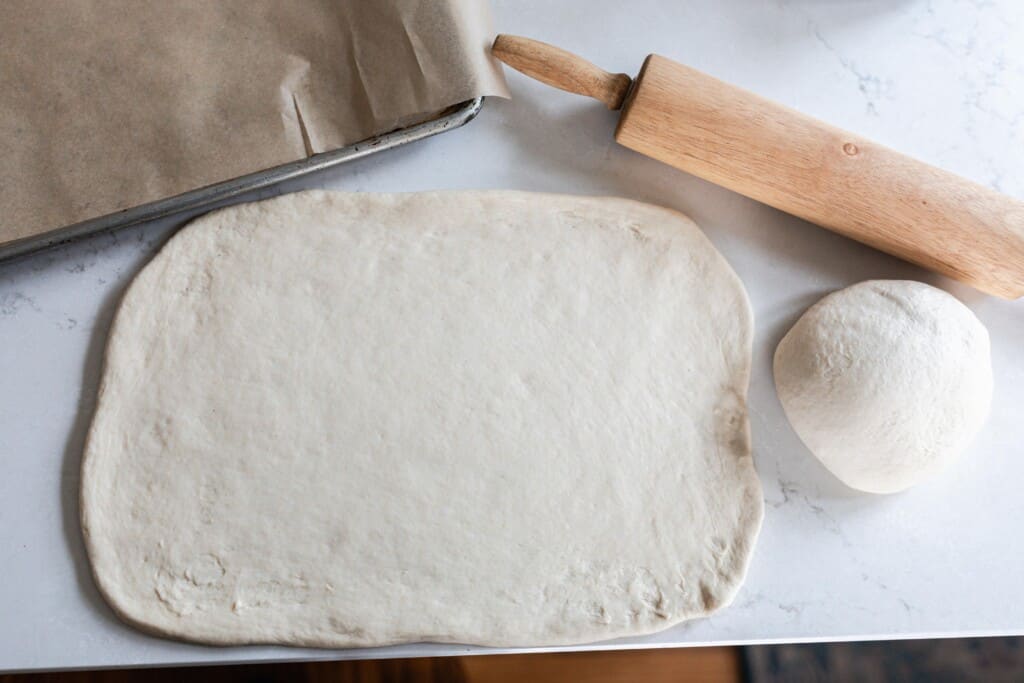
Shape it by rolling the dough into a flat rectangle (about 1/4 – 1/2 inch thickness) and roll up. Pinch the seam.
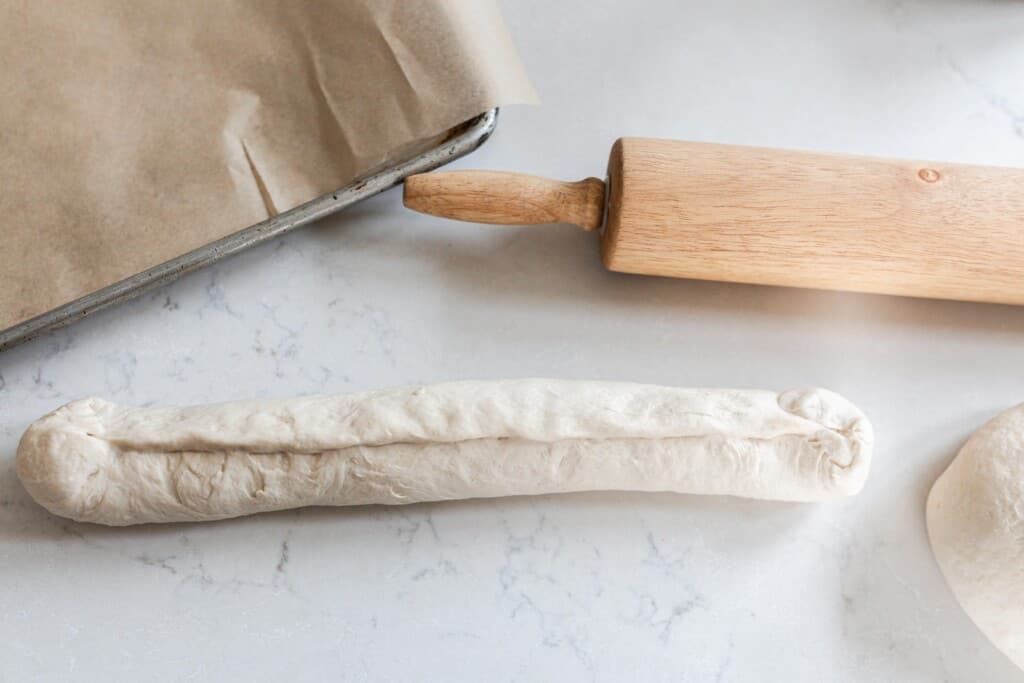
Place French bread dough onto a parchment-lined baking sheet.
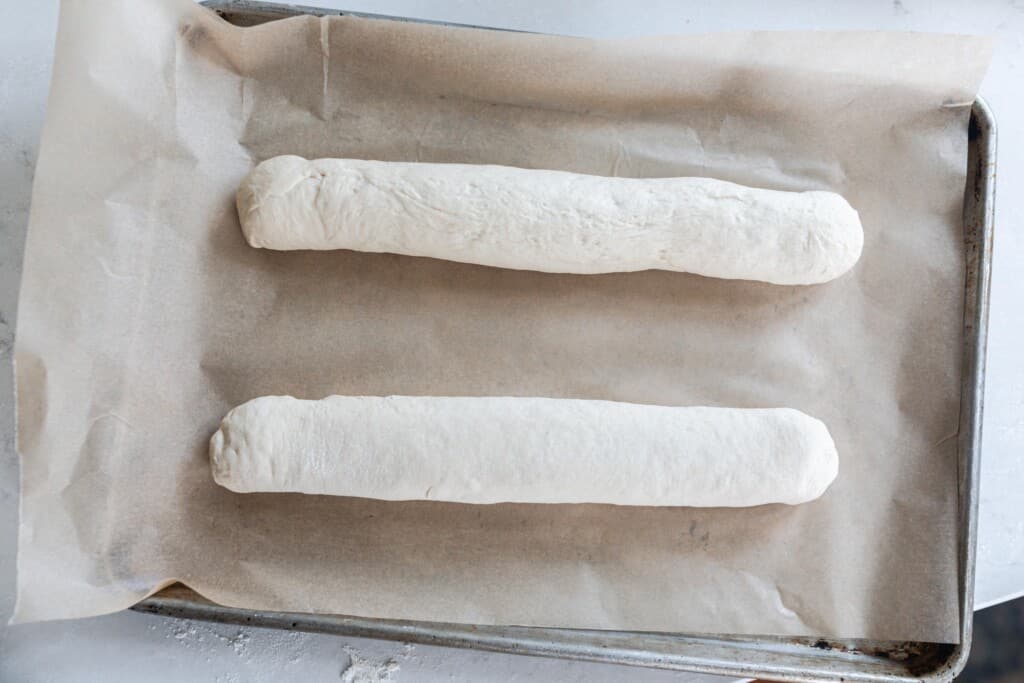
Cover with a towel and allow to rise until doubled again. This could take a few hours depending on how warm your kitchen is.
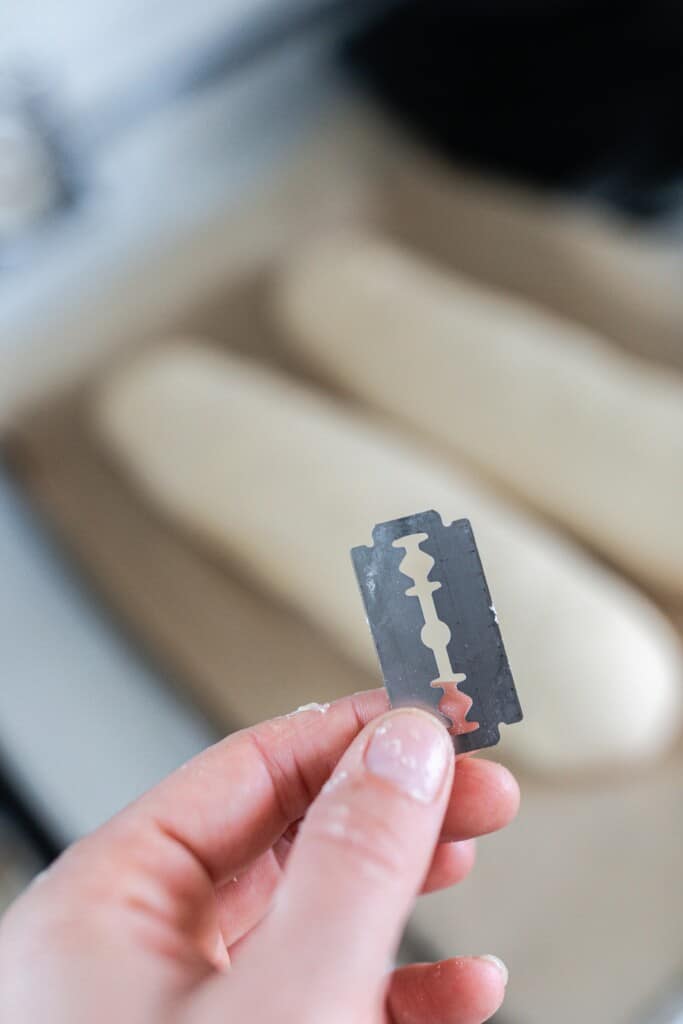
Slash with lame.
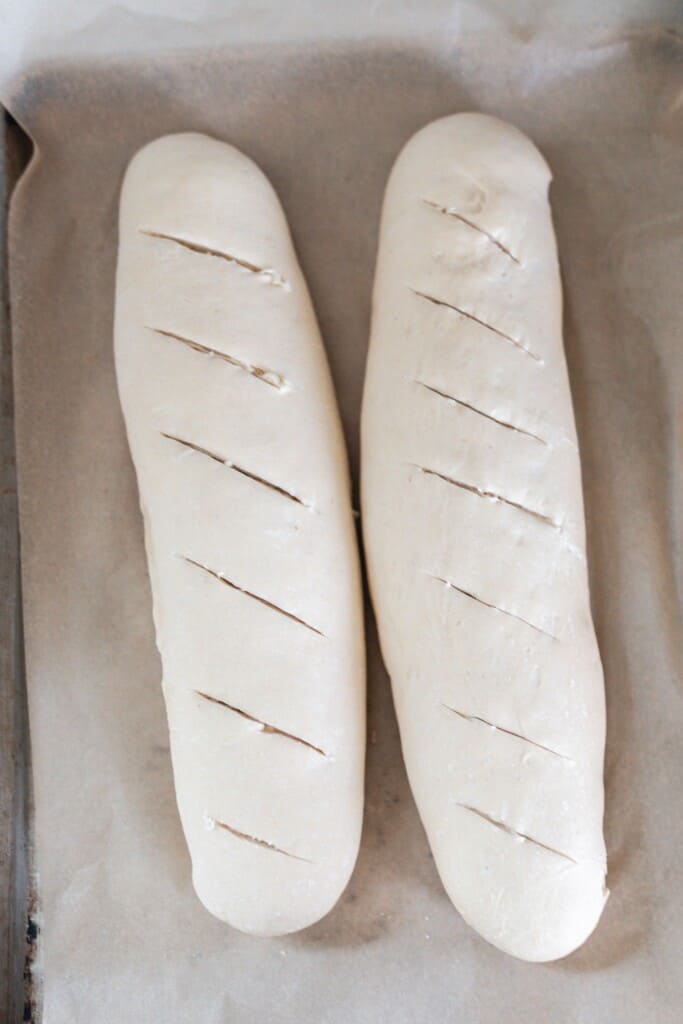
Preheat to 400. Bake for 25 minutes.
For a more golden crust, add ice cubes in the oven. This helps add moisture and steam to make that golden, crustier crust.
Once it is done baking, pull it out of the oven and allow to cool completely before slicing.
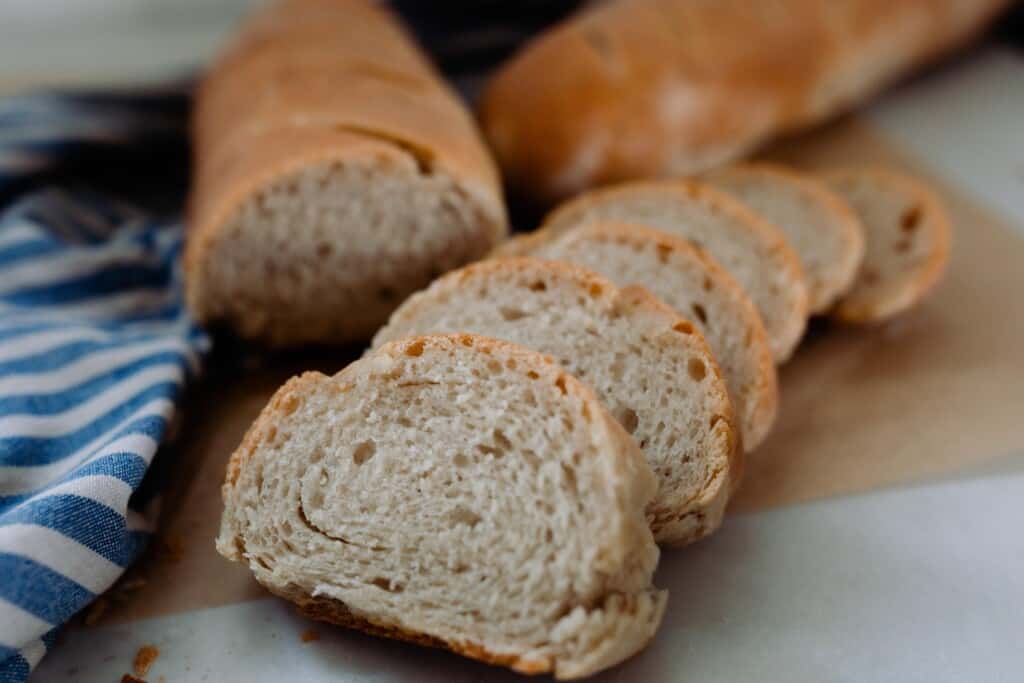
Find More Delicious Sourdough Recipes:
- Sourdough Chocolate Cupcakes
- Sourdough Sandwich Rolls
- No-Knead Sourdough Bread
- Sourdough Blueberry Muffins
- Homemade Sourdough Bagels
If you try this recipe and love it, I would love if you could come back and give it 5 stars! Tag me on Instagram @farmhouseonboone
Sourdough French Bread
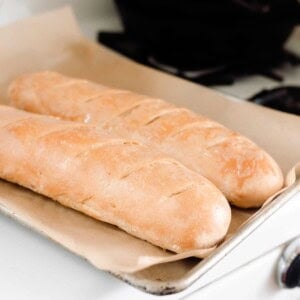
Ingredients
- 1 cup sourdough starter, 227 g
- 1 1/4 cups water, 295 g
- 2 teaspoon salt and, 10 g
- 4 cups all-purpose flour, 560 g
- 1 tablespoon honey, 21 g
- 2 tablespoons olive oil, 27 g
Instructions
- Feed your starter 4-12 hours before starting this recipe. It should be very active and bubbly.
- To your mixing bowl, add all of the ingredients.
- Knead in a stand mixer using the dough hook until stretchy and pulling away from the sides of the bowl. This should take about 5-10 minutes. It should pass the ‘windowpane’ test, which is when you take a small piece of the dough and try to stretch it into a square-like shape. If you can stretch it thin enough where you can “see through it”, then the gluten formation is adequate.
- Place in a large, oiled bowl and cover with plastic wrap, beeswax wrap, or something that is airtight. This will keep the dough moist, preventing it from developing a hard skin.
- Allow to ferment for 8 to 24 hours in a warm place. The next day, it should have at least doubled in size.
- Punch down the dough. Divide into two equal parts.
- Shape it by rolling the dough into a flat rectangle (about 1/4 – 1/2 inch thickness) and roll up. Pinch the seam.
- Place French bread dough onto a parchment-lined baking sheet.
- Cover with a towel and allow to rise until doubled again. This could take a few hours depending on how warm your kitchen is.
- Slash with lame.
- Preheat to 400. Bake for 25 minutes. (For a more golden crust, add ice cubes in the oven. This helps add moisture and steam to make that golden, crustier crust.)
- Once it is done baking, pull it out of the oven and allow to cool completely before slicing.
Notes
- For a more golden crust, add ice cubes in the oven for a crustier crust.
- The windowpane test is when you take a small piece of the dough and try to stretch it into a square-like shape. If you can stretch it thin enough where you can “see through it”, then the gluten formation is adequate. If, after kneading, your dough just breaks apart, then knead it longer until it can pass this test.
Nutrition
Nutrition information is automatically calculated, so should only be used as an approximation.
















So disappointed. I made the dough the afternoon before baking. My dough rose overnight. About 12 hours after starting the process, I punched down the dough to separate into two loaves. The dough was heavier than I expected. I rolled out to a rectangle and rolled the two loaves, placed on a baking sheet, then covered with a towel. After about 4 hours, there was some spread… but not a rise, despite the warmth of the area. I decided to bake as instructed, placing ice in the bottom of the oven. The loaves were heavy and ultimately gummy in the middle. ( sigh ) 2-days of effort. I had to throw them away.
I don’t recommend punching down a loaf like you would with traditional bread dough!
Is it 2 teaspoon and 10 grams of salt or should it be
2 teaspoons or 10 grams of salt?
Love all your recipes!
OR
I’m sure this recipe is amazing because every other recipe I’ve tried has been so good, however, this one turned out a failure and I’m hoping to figure out why… From the beginning I followed the recipe to a T but it seemed wet and sticky. I kneaded longer to bring it to a silky state but never got there. It rose beautifully in the bowl but still super sticky and not silky. This morning I could not shape it at all so I added a little flour to assist in shaping. It was still sticky and flat. It never rose and barely browned. I’m thinking maybe the water amount was too much? Is that due to humidity?
Ps. The brownie recipe is the best ever!!! Drooling happens when I make it.
It could have been due to the humidity. It seems like it may have needed a bit more flour before you started the kneading process or it could have over fermented. Usually an over fermented dough or an over kneaded dough can cause the gluten to lose its structure and then it struggles with the rising process and is unworkable.
What type of flour did you use?
All-purpose! Sorry about that.
If I wanted to use einkorn, would I just reduce the amount of water to get the desired consistency?
Yes!
Love this recipe. I used a sour starter that is 100% hydration and my dough was very soft and a little hard to work with. What would you suggest? I’m new to making sour dough bread and I’m guessing I just add less water when I’m making up the recipe? What would you suggest? Help please:)
And Thank you lol
Yes, hold off on that last bit of water to see if that helps!
This was a very easy to follow recipe:) Thank you!! Only comment I would say is about putting the ice cubes in the oven… I heated the oven to 400 degrees and THEN put the tray of ice cubes in the bottom for steam… what I didn’t realize is that the ice cubes reduced my oven temperature to 300 degrees!! EEK! So, if you are going to use ice cubes, put them in as you are preheating the oven. My loafs took a little longer to cook but are edible lol:)
This is a great recipe & as easy as you said. The dough did double no flat sourdough this time, the loaves turned out great as well. Plus the bread tastes wonderful, not dry, & my husband liked it too.
Finally!!! A French bread recipe that turns out like what we get in the restaurants…only better.
Thank you!
Thanks for the feedback!
How can I do this without a stand mixer?
You can knead by hand, it will just take a bit longer.
I just found that you can put all the ingredients in a bread machine and use the dough cycle. Then take out and let it continue rising in your proofing bin. It kneaded wonderfully.
I missed the instruction about the plastic wrap to keep it from making a skin. I had a tea towel on it. I just punched it down and made the loaves for the second rise. I’m making this for company so need to go buy bread if my mistake is going to ruin the loaves. Thoughts?? Thank you!
It won’t ruin the loaves!